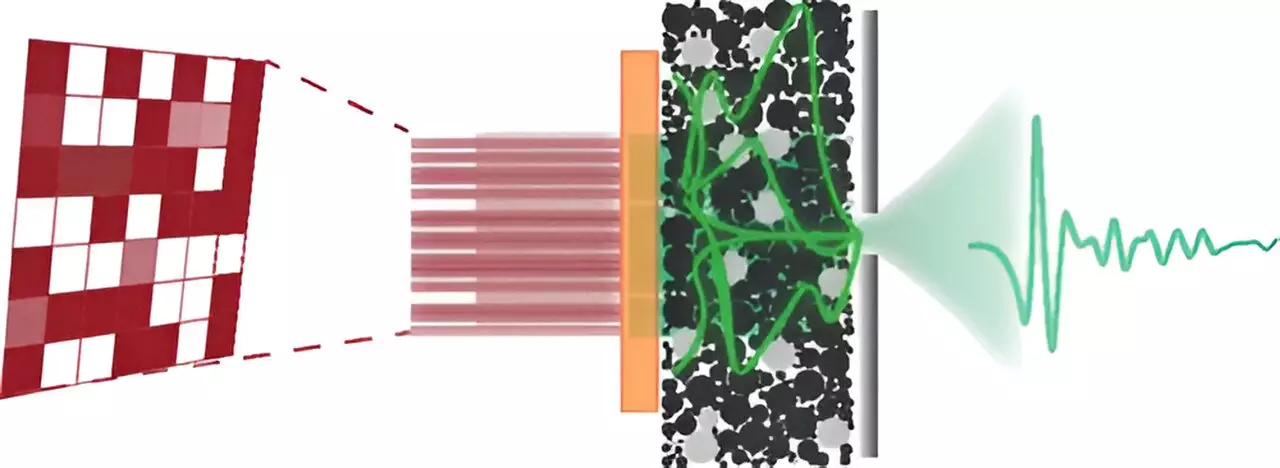In a breakthrough discovery, a research team has developed a groundbreaking technique that allows for precise control of terahertz waves as they pass through disordered materials. This method has far-reaching implications and holds the potential to revolutionize medical imaging, communications, and various other applications that rely on broadband terahertz pulses. The research, conducted as part of the European Union ERC project TIMING, represents a collaborative effort between members of Loughborough’s Emergent Photonics Research Center and Prof Jacopo Bertolotti from Exeter University.
Traditionally, disordered systems have been perceived as limitations to clarity, much like looking through frosted glass. The scattering of light within these materials, similar to how fog distorts our vision, has long posed challenges in the realm of optics. However, a more modern approach casts disordered systems as “Complex media,” revealing a strikingly different narrative. While information may appear scrambled within these systems, it is not irretrievably lost. In fact, this scrambling can be harnessed to manipulate light itself.
Terahertz waves, a type of electromagnetic radiation lying between microwaves and infrared light, play a vital role in bridging the gap between electronics and photonics. These waves, though highly sought after, are notoriously difficult to generate, detect, and manipulate. Yet, they possess unique properties that make them immensely valuable. Terahertz waves can penetrate materials such as clothing, paper, and plastic, providing clear images without the harmful effects of ionizing damage caused by X-rays. Additionally, they can facilitate high-performance communication links.
However, when terahertz waves propagate through complex structures like biological tissue or technological structures, they become distorted. Imaging through complex media poses both challenges and opportunities. In this groundbreaking study, researchers utilized an ultrafast laser renowned for its extremely short pulses to create patterns of terahertz pulses. With the aid of a specially designed genetic algorithm that mimics natural evolution, they manipulated the laser’s illumination, gaining precise control over the distribution and evolution of terahertz waves as they passed through the material.
The researchers effectively recomposed scrambled pieces of the wave, forming a new wave with desired patterns and colors. Dr. Vittorio Cecconi, the lead researcher, highlights the significance of this achievement, stating, “It is remarkable that complex media operate as sophisticated devices that manipulate terahertz waves in ways that were previously out of reach.” He further emphasizes that despite their complex nature, these media are composed of accessible random assemblies of particles. This newfound level of control opens up boundless possibilities for utilizing terahertz waves in imaging and sensing applications, especially in scenarios where scattering is a prevalent issue.
This groundbreaking approach, laden with multidisciplinary ramifications, is made possible by the availability of methods to measure the evolution of the terahertz electric field. In the domain of terahertz, this is accomplished through a methodology known as Nonlinear Ghost Imaging, which offers insights into the interaction between waves and optical materials. This methodology is unique to photonics, as the electric field, the oscillating quantity in electromagnetic waves, is not generally measurable for light. The commonly accessed quantity is the intensity, which distinguishes terahertz waves from other waves in the electromagnetic spectrum.
Dr. Cecconi emphasizes the synergy between Nonlinear Ghost Imaging and complex media, which has paved the way for groundbreaking research and unlocked numerous advanced applications, including terahertz computing. Prof Peccianti, the director of the Emergent Photonics Research Center, underscores the center’s mission to explore the intersection between ultrafast photonics and complexity, further solidifying the importance of interdisciplinary collaboration in driving scientific progress.
The development of a technique enabling precise control of terahertz waves as they pass through disordered materials marks a groundbreaking advancement in the field of optics. This discovery has the potential to significantly impact a wide range of applications such as medical imaging, communications, and sensing. By harnessing the scattering properties of complex media, researchers have successfully overcome the limitations previously associated with disordered systems. The ability to manipulate terahertz waves with such precision opens up a new realm of possibilities for technological advancements, bringing us closer to a future where complex media serve as powerful tools in shaping our interaction with light. As we venture further into the uncharted territories of ultrafast photonics and complexity, the potential for further breakthroughs and advancements becomes increasingly apparent.


Leave a Reply